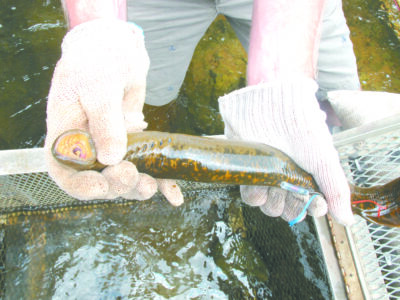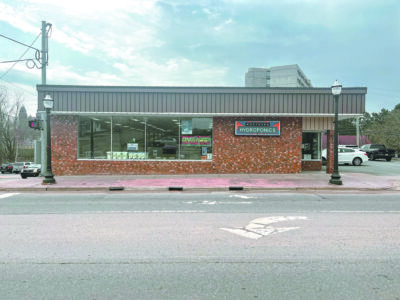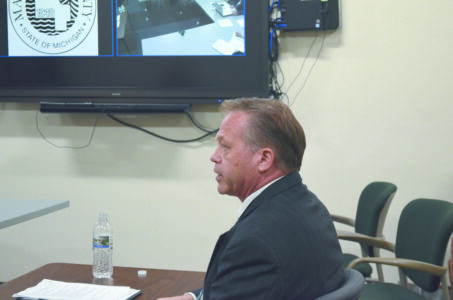Copper Country residents learn of Normandy invasion

This map of the invasion area of France appeared on the front page of the June 6, 1944, edition of the Daily Mining Gazette. The 100-mile-wide invasion beach is in the center of the map, between Le Havre, on the right and Cherbourg on the left. (Houghton Daily Mining Gazette file photo)
HOUGHTON — All across the Copper Country, night shift workers were clocking out, ending their work day while day shift workers were waking up and preparing for their day.
For anyone who had the radio turned on, the news came as a shock when they heard the transmission come through: “CBS News, Bob Trout speaking. We are going to bring you the available reports, all of them from German sources, on what the Berlin Radio calls ‘the invasion.'”
It was June 6, 1944, and what most people across the world had been expecting was reportedly occurring in Western Europe.
“There is still no Allied confirmation from any source,” Trout’s report continued. “Correspondents who rushed to the War Department, in Washington, soon after the first German broadcasts were heard, were told that our War Department had no information on the German reports. There’s been no announcement of any sort from Allied Headquarters in London.”
Trout went on to say that the first German announcement of the news had reached the United States at 12:37 a.m. Eastern War Time (6:37 a.m. local time), which was six hours behind the time on the invasion beaches.
“The Associated Press recorded this broadcast,” cautioned Trout, “and immediately pointed out that it could be one that Allied leaders had warned us to expect from the Germans.”
Germany’s international shortwave radio service, Trans-Ocean, reported that “a grand scale amphibious landing” was taking place along the northern coast of France near the Normandy Peninsula. Monitored in London, this report was picked up by the Associated Press and was sent via teletype to the newsrooms of the major radio networks.
“Shortly after 1 a.m., Eastern War Time, the Berlin Radio opened its news program with a so-called invasion announcement.”
Old Time Radio Catalog at OTRCAT.com summarized the news report broadcasts.
At around 2 a.m., NBC interrupted its regularly scheduled program with a bulletin saying German radio was reporting that the D-Day invasion of Europe had begun, with Allied troop landings along the northern coast of France.
NBC continued interruptions of its programs with additional updates on what German radio was reporting: that the French port of La Havre is being shelled, that airborne troops have landed near the mouth of Seine River, and that German naval craft are battling Allied landing craft off the northern coast of France. NBC’s bulletins emphasized that these were German reports and that there has been no official confirmation that the invasion has begun. As Trout had stated earlier, the War Department had stated that it has no information on the reports being broadcast by German radio.
At home, those hearing the radio broadcasts would have to wait for confirmation from Allied sources. Many Copper Country parents had sons in the military, and of course, they were eager to know anything, any tiny detail. Later in the day, the Daily Mining Gazette provided a bit more detail. Most of the June 6, 1944, edition consisted of reports from the front.
Between the radio reports and the newspaper accounts, it became clear to those on the homefront that the action in Western Europe was chaotic, confused and violent. Slowly, they began to piece together the reports to create at least a vague understanding of events.
Around dawn, approximately 160,000 American, British and Canadian troops, in nearly 7,000 ships and other craft, went ashore on the beaches of Normandy, in northwestern France, taking German commanders by surprise. Like everyone else, the Germans knew the invasion was coming sooner or later, but they did not expect June 6 because of the adverse weather conditions. Also due to a sophisticated ruse by the British and Americans, the Germans were expecting landings to the northeast, in the Pas-de-Calais area. Even as more Allied waves stormed ashore at Normandy, the Germans remained convinced that it was a decoy.
The 100-mile stretch of Normandy shoreline, between La Havre and Cherbourg, was divided into five transport off-loading sectors, two American, called the Utah and Omaha beaches, and three British-Canadian, named Gold, Juno and Sword.
Navy battleships and cruisers bombarded enemy coastal fortifications and strongpoints. Destroyers and smaller craft provided additional gunfire support, which were followed by tactical air strikes, as landing craft carried troops and vehicles to the beach areas.
Just after midnight on June 6, Allied airborne troops began dropping behind enemy lines. Their task was to blow up bridges, sabotage railroad lines and take other measures to prevent the enemy from rushing reinforcements to the invasion beaches. Hours later, the largest amphibious landing force ever assembled began moving through the storm-tossed waters toward the beaches. Most of the Americans were packed into flat-bottomed Higgins boats launched from troop transports 10 miles from the French coastline. Vomit filled the bottom of the boats, and as water kept rushing in over the gunwales, the green-faced men had to bail this vile stew with their helmets. Though it was cold, the men were sweating.
For the Americans, Omaha was a near-suicide mission, according to the Library of Congress. First, a powerful undertow swept away lives and weapons; 10 landing craft with 26 artillery guns and 22 of 29 tanks were swamped. Then, they faced a maelstrom of bullets. Within 10 minutes of landing, every officer and sergeant of the 116th Regiment was dead or wounded. Yet, by 10 a.m., as Americans received the first news of D-Day, 300 men had struggled through mortar fire, across the body-and-equipment-strewn beach, and up a bluff to attack the German defenses. By nightfall, the Allies had a toehold on the continent, yet, on “Bloody Omaha” alone, 3,000 Americans lay dead.
This was the final phase of Operation Overlord, a code name for the cross-channel invasion of France, the planning for which had begun more than a year earlier in May 1943.
Known today as D-Day, it was initially simply referred to as the invasion. D-Day was simply a military designation for a given day on which an invasion would occur, in this instance, June 6. The success of the invasion gave the Allies an established beachhead to be used as a port for incoming supplies; it also sealed Germany’s doom, because now, there were two powerful military forces on the European continent, one moving east, while the other one would move west, catching the Germans between them. Fortress Europa had been breached.






